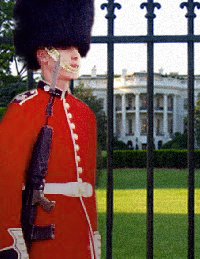As for the legal framework of the decision, read Aziz Huq, Associate Counsel of the Brennan Center for Justice at NYU School of Law, guest-blogging on the ACSblog:
The Hamdan decision rejects this fast-and-loose attitude to the Separation of Powers. It endorses careful scrutiny of the precise powers delegated by Congress to the executive branch. The Court thus properly rejected Justice Thomas's extraordinary idea that the "structural advantages attendant to the Executive Branch" in war-time--aspects of executive power that make that branch the "most dangerous" to individual liberty today--merit a hands-off approach by the courts. (Ironically, Justice Thomas refers to Justice Stevens' "unfamiliarity with the realities of warfare"; but Stevens served in the U.S. Navy from 1942 to 1945, during World War II. Thomas's official bio, by contrast, contains no experience of military service. Justice Stevens suffers another unwarranted ad hominim attack from Justice Scalia, who refers to Stevens' sarcasm). In short, Hamdan follows the wisdom of Justice Souter's concurrence in Hamdi: "For reasons of inescapable human nature, the branch of government asked to counter a serious threat is not the branch on which to rest the Nation's reliance in striking the balance between the will to win and the cost in liberty on the way to victory."
The Court's decision to rest its holding on the Milligan/Youngstown vision of separate branches, sharing powers represents an important blow to the present Administration's campaign to accumulate the powers to make laws, enforce laws, and then punish those it deems in violation of those laws. As Jane Mayer nicely explains in this week's New Yorker (and as developed at length in the book by Fritz Schwarz and me to be published at the beginning of 2007), this vision is understood by the Vice-President and others to be at the core of this Administration's legacy: Hamdan rejects that legacy. This surely will be one of the decision's pivotal long-term legacies.





